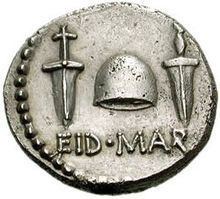 | ||
The Ides of March (Latin: Idus Martiae, Late Latin: Idus Martii) is a day on the Roman calendar that corresponds to 15 March. It was marked by several religious observances and became notorious as the date of the assassination of Julius Caesar in 44 BC. The death of Caesar made the Ides of March a turning point in Roman history, as one of the events that marked the transition from the historical period known as the Roman Republic to the Roman Empire.
Contents
Although March (Martius) was the third month of the Julian calendar, in the oldest Roman calendar it was the first month of the year. The holidays observed by the Romans from the first through the Ides often reflect their origin as new-year celebrations.
Ides
The Romans did not number days of a month sequentially from the first through the last day. Instead, they counted back from three fixed points of the month: the Nones (5th or 7th, depending on the length of the month), the Ides (13th or 15th), and the Kalends (1st of the following month). The Ides occurred near the midpoint, on the 13th for most months, but on the 15th for March, May, July, and October. The Ides were supposed to be determined by the full moon, reflecting the lunar origin of the Roman calendar. On the earliest calendar, the Ides of March would have been the first full moon of the new year.
Religious observances
The Ides of each month were sacred to Jupiter, the Romans' supreme deity. The Flamen Dialis, Jupiter's high priest, led the "Ides sheep" (ovis Idulius) in procession along the Via Sacra to the arx, where it was sacrificed.
In addition to the monthly sacrifice, the Ides of March was also the occasion of the Feast of Anna Perenna, a goddess of the year (Latin annus) whose festival originally concluded the ceremonies of the new year. The day was enthusiastically celebrated among the common people with picnics, drinking, and revelry. One source from late antiquity also places the Mamuralia on the Ides of March. This observance, which has aspects of scapegoat or ancient Greek pharmakos ritual, involved beating an old man dressed in animal skins and perhaps driving him from the city. The ritual may have been a new year festival representing the expulsion of the old year.
In the later Imperial period, the Ides began a "holy week" of festivals for Cybele and Attis. The Ides was the day of Canna intrat ("The Reed enters"), when Attis was born and exposed as an infant among the reeds of a Phrygian river. He was discovered—depending on the version of the myth—by either shepherds or the goddess Cybele, who was also known as the Magna Mater, "Great Mother". A week later, on 22 March, the day of Arbor intrat ("The Tree enters") commemorated the death of Attis under a pine tree. A college of priests called "tree bearers" (dendrophoroi) cut down a tree, suspended from it an image of Attis, and carried it to the temple of the Magna Mater with lamentations. The day was formalized as part of the official Roman calendar under Claudius. A three-day period of mourning followed, culminating with the rebirth of Attis on 25 March, the date of the vernal equinox on the Julian calendar.
Assassination of Caesar
In modern times, the Ides of March is best known as the date on which Julius Caesar was assassinated in 44 BC. Caesar was stabbed to death at a meeting of the senate. As many as 60 conspirators, led by Brutus and Cassius, were involved. According to Plutarch, a seer had warned that harm would come to Caesar no later than the Ides of March. On his way to the Theatre of Pompey, where he would be assassinated, Caesar passed the seer and joked, "The Ides of March are come", implying that the prophecy had not been fulfilled, to which the seer replied "Aye, Caesar; but not gone." This meeting is famously dramatised in William Shakespeare's play Julius Caesar, when Caesar is warned by the soothsayer to "beware the Ides of March." The Roman biographer Suetonius identifies the "seer" as a haruspex named Spurinna.
Caesar's death was a closing event in the crisis of the Roman Republic, and triggered the civil war that would result in the rise to sole power of his adopted heir Octavian (later known as Augustus). Writing under Augustus, Ovid portrays the murder as a sacrilege, since Caesar was also the Pontifex Maximus of Rome and a priest of Vesta. On the fourth anniversary of Caesar's death in 40 BC, after achieving a victory at the siege of Perugia, Octavian executed 300 senators and knights who had fought against him under Lucius Antonius, the brother of Mark Antony. The executions were one of a series of actions taken by Octavian to avenge Caesar's death. Suetonius and the historian Cassius Dio characterised the slaughter as a religious sacrifice, noting that it occurred on the Ides of March at the new altar to the deified Julius.
